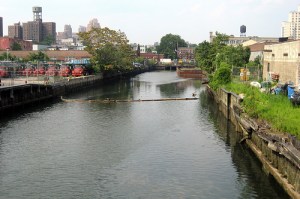 In the wake of the EPA’s decision to designate the Gowanus Canal as a Superfund site, pro-designation activists celebrated the morning of the event with jubilant emails and phone calls.
In the wake of the EPA’s decision to designate the Gowanus Canal as a Superfund site, pro-designation activists celebrated the morning of the event with jubilant emails and phone calls.
“We did it!” whooped Linda Mariano, a member of the Friends and Residents of Greater Gowanus (F.R.O.G.G.), in a phone interview on Tuesday. “I always said it, and I never gave up hope! And now the Toll Brothers are out, ha!”
“HALLELUJAH!… HALLELUJAH!…. a long awaited and welcoming announcement!” wrote Ludger K. Balan on the F.R.O.G.G. mailing list. He is the environmental program director at the Urban Divers Estuary Conservancy, a nonprofit organization that seeks to restore healthy conditions in the New York and New Jersey harbor estuary.
F.R.O.G.G. organized letter-writing campaigns and reached out to community leaders and members to support the Superfund effort. According to EPA spokesperson Beth Totman, the agency received over 1,300 public comments in the 90 days following the Gowanus nomination last April.
“At most sites, we get five to 20 comments,” Ms. Totman said. “But this was certainly out of the ordinary.”
Although Mayor Bloomberg proposed an alternative cleanup plan, citing the stigma of Superfund and the length of time in the cleanup, the EPA had doubts about the city’s ability to pay for the extensive work required.
“With their approach, the funding didn’t have sure ground,” Ms. Totman said. “With the Superfund growth we have the legal authority to compel responsible groups to pay for the cleanup. We don’t have to rely on congressional earmarks to get the job done.”
The alternative approach relied on the Resources Development Act, in which the Army Corps of Engineers gets $50 million a year for pollution sites around the country. This was not sufficient, according to Ms. Totman. “There are thousands of sites on that list that are waiting to get funding,” she said.
A spokesman for Mayor Bloomberg, Marc LaVorgna, responded to requests for comment by email:
It’s disappointing. We had an innovative and comprehensive approach that was a faster route to a Superfund-level cleanup and would have avoided the issues associated with a Superfund listing. The project will now move on a Superfund timeline, but we are going to work closely with the EPA because we share the same goal – a clean canal.
Some of the groups identified by the EPA as responsible for pollution (and therefore, likely responsible for funding the cleanup), include the City of New York, ConEd, National Grid, CIBRO Petrol Products, the Chemtura Corporation, and the U.S. Navy.



